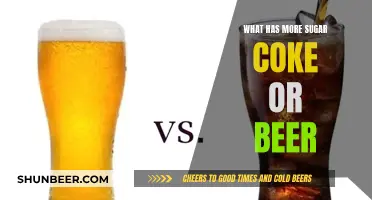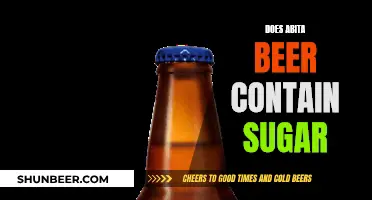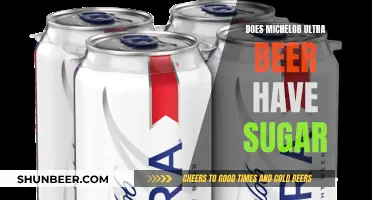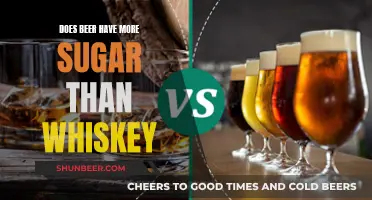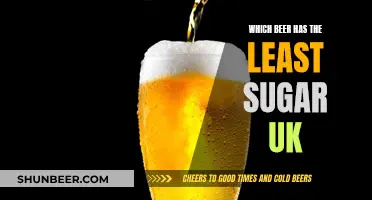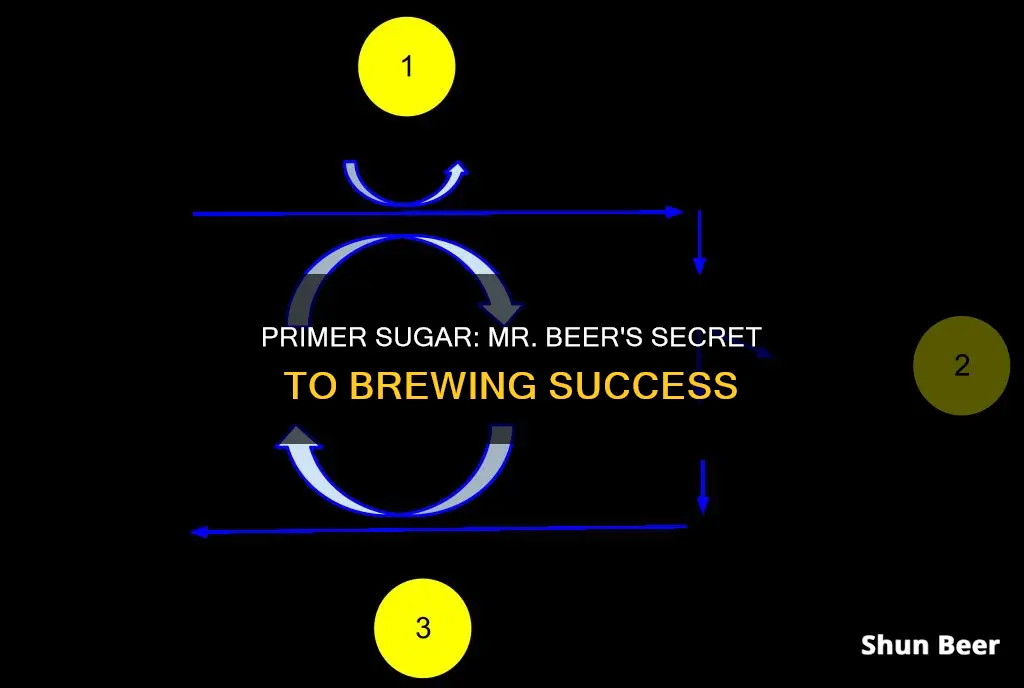
Carbonation is an essential part of the beer-making process, and priming sugar is key to achieving the right level. Mr Beer offers a range of products to help with this, including carbonation drops, which are sugar tablets pre-measured to carbonate bottles. These are mess-free and simple to use. Mr Beer also recommends adding priming sugar or carbonation drops to bottles before filling them with beer, as this reduces the risk of oxygenation. Other sugars that can be used for priming include table sugar, corn sugar, and DME.
| Characteristics | Values |
|---|---|
| Purpose | Carbonation, creating CO2 and alcohol |
| When to add | Before filling bottles |
| Why add before filling bottles | Easier to handle, prevents oxygenation |
| How to add | Carbonation drops or sugar |
| Shaking bottles | Not recommended |
| Priming sugar types | Table sugar, corn sugar, DME, honey |
| Priming sugar calculation | Depends on target carbonation level |
| Priming solution | Boil priming sugar in water, cool, then add to bottling bucket |
What You'll Learn

Primer sugar is added to bottles before filling with beer
Primer sugar is added to bottles before filling them with beer. This is done to create carbonation, which gives beer its fizz and enhances its flavour. Primer sugar is the main component in the priming solution, which is added to the brew during bottling. The yeast in the bottle consumes the sugar, producing carbon dioxide (CO2) and creating effervescence, or bubbles, in the beer. This process is called bottle conditioning or bottle fermentation, and it is the final step in the brewing process.
Mr. Beer recommends adding primer sugar or carbonation drops to the bottles before filling them with beer. This method is easier to handle and reduces the risk of oxygenation, which can cause off-flavours in the beer. The carbonation drops are sugar tablets that are pre-measured to carbonate the bottle sizes provided in the Mr. Beer kits, making the process mess-free and simple.
The amount of primer sugar used will determine the final carbonation level in the beer. It is important to use the correct amount of sugar to achieve the desired level of carbonation. Homebrewers can refer to priming sugar charts or use priming sugar calculators to determine the right amount of sugar for their brew.
Primer sugar can be added directly to the bottles or mixed with water to create a priming solution. If creating a priming solution, it is recommended to boil the water and stir in the sugar until it is completely dissolved. This solution is then added to the bottling bucket before siphoning the brew from the carboy into the bucket. It is important to handle the brew gently and avoid shaking the bottles to prevent oxygenation and off-flavours.
Overall, adding primer sugar to bottles before filling them with beer is an essential step in the brewing process to create carbonation and enhance the flavour of the beer.
Tiger Beer's Sweet Secret: Sugar Content Revealed
You may want to see also

Primer sugar creates carbonation
Primer sugar is an essential component in creating carbonation in beer. Carbonation not only adds fizz to the beer but also enhances the overall drinking experience by carrying volatile aroma compounds to the nose and activating the trigeminal nerve in the mouth.
The process of carbonation involves adding primer sugar to the beer during bottling, initiating a secondary fermentation that creates carbon dioxide (CO2) bubbles, resulting in a refreshing, bubbly beverage. This secondary fermentation occurs in airtight bottles, allowing the CO2 to build up pressure and dissolve back into the beer, creating a carbonated brew.
The amount of primer sugar used plays a crucial role in determining the final carbonation level. Too little sugar can result in flat beer, while too much can lead to over-carbonation and potential bottle bombs. Therefore, precise calculations are necessary to achieve the desired carbonation level and avoid unpleasant surprises.
Mr. Beer offers a range of sugar options for priming, including table sugar, corn sugar, and dry malt extract (DME). Each type of sugar requires specific calculations to maximise its efficacy as a primer. Additionally, Mr. Beer provides carbonation drops, which are pre-measured sugar tablets that simplify the carbonation process and ensure consistent carbonation in each bottle.
The timing of adding primer sugar is also important. Mr. Beer recommends adding the primer sugar or carbonation drops before filling the bottles with beer. This method makes handling the bottles easier and reduces the risk of oxygenation, which can cause off-flavours in the beer.
The Truth About IPA Beer and Sugar Content
You may want to see also

Different types of primer sugar
Priming sugar is an essential component of the priming solution used in the carbonation process of brewing beer. It provides food for the yeast to create carbonation, resulting in a bubbly and refreshing beverage. While various sugars can be used for priming, the most popular types are corn sugar (dextrose), table sugar (sucrose), and dry malt extract (DME). Each type of sugar has its unique characteristics and requires specific calculations for optimal carbonation.
Corn Sugar (Dextrose)
Corn sugar, also known as dextrose, is a popular choice for priming sugar due to its high fermentability. It typically contains about 9% water, which means only 91% of its mass contributes to carbonation calculations. Corn sugar is used in the formula: CF + .5 x (.91D)/VB = CB, where CF is the initial CO2 level, D is the amount of corn sugar, VB is the volume of beer, and CB is the desired carbonation level.
Table Sugar (Sucrose)
Table sugar, or sucrose, is another commonly used priming sugar. Unlike corn sugar, table sugar does not contain water, so a "fifty percent" rule is applied, multiplying the amount of sugar by half in the calculations. The formula for table sugar is: CF + .5(S)/VB = CB, where CF is the initial CO2 level, S is the amount of table sugar, VB is the volume of beer, and CB is the desired carbonation level.
Dry Malt Extract (DME)
Dry malt extract (DME) is a unique priming sugar that requires additional calculations to determine the correct amount of carbonation it will produce. The formula for DME is: CF + .5FTx (X/VB) = CB, where CF is the initial CO2 level, FT is the true fermentability of the DME, X is the amount of DME, VB is the volume of beer, and CB is the desired carbonation level. The true fermentability of DME is calculated by multiplying the apparent fermentability (FA) by 0.82.
Honey
Honey is a less conventional priming agent that can be tricky for novice brewers due to its variable density, composition, and viscosity. It is generally used for darker brews, with 1/2 to 1 cup of honey recommended for priming five gallons of beer. To calculate the precise amount of honey needed, brewers must determine its specific gravity and compare it to that of a sucrose solution.
In summary, the choice of priming sugar depends on the brewer's preference, the type of beer being made, and the desired level of carbonation. Each type of sugar has its own formula for calculating the optimal amount to use, ensuring the desired carbonation level is achieved and resulting in a tasty, bubbly beer.
Sugar Cubes in Beer: How Many is Too Many?
You may want to see also

Primer sugar can be added to the whole batch
Primer sugar is added to beer to create carbonation, which gives beer its fizz and helps carry volatile aroma compounds up to your nose, giving beers a discernable smell. It also activates the trigeminal nerve in your mouth, and different levels of carbonation feel differently when they hit this nerve.
Batch priming refers to the process of adding primer sugar to the entire batch of beer instead of individual bottles. Fans of batch priming list simplicity and consistent carbonation from bottle to bottle as the primary benefits. When beer styles call for very precise levels of sugar, for example, it is much easier to prime the whole batch.
However, Mr. Beer advises against batch priming. Firstly, you would need to use a second fermenter to rack to, tubing to rack with, and a sanitizer, which are added expenses and work. Secondly, batch priming allows for possible oxidation. All the movement of getting the beer from one fermenter to another, and then to the bottles, means exposing your beer to oxygen. If you use a bottling wand, your beer won't be exposed to oxygen until you open it.
If you are brewing larger batch sizes, using carbonation drops and a bottling wand will be a better benefit than batch priming.
Non-Alcoholic Beer: Sugar-Free or Not?
You may want to see also

Primer sugar can be added to individual bottles
Primer sugar is an essential component of the priming solution used in the carbonation process of brewing beer. It provides food for the yeast, which creates carbonation or effervescence in the form of carbon dioxide (CO2) bubbles. This process, known as bottle conditioning, occurs during the final fermentation stage, resulting in a refreshing, bubbly beer.
While some brewers prefer batch priming, where the primer sugar is added to the entire batch of beer, Mr. Beer recommends a different approach. They suggest adding primer sugar to individual bottles before filling them with beer, making it easier to handle the bottles and reducing the risk of oxygenation. This method also ensures consistent carbonation levels and eliminates the need for additional equipment and sanitization.
Mr. Beer offers Carbonation Drops, which are sugar tablets pre-measured to carbonate the bottle sizes provided in their kits. These tablets provide convenience, precision, and flexibility during bottling. They eliminate the need for calculations, reducing the risk of over-priming and bottle bombs. Additionally, they remove the need to sterilize the sugar and allow for direct addition to the bottles, streamlining the bottling process.
For those who prefer to calculate and measure their primer sugar, Mr. Beer provides a priming sugar conversion chart to determine the appropriate amount for specific bottle sizes. This method offers the ability to fine-tune the carbonation level to match the desired target carbonation for the beer style being brewed.
By following the recommended process of adding primer sugar to individual bottles, brewers can achieve consistent carbonation, minimise oxidation, and simplify the overall brewing experience with Mr. Beer.
Cider Beers: Sugar Content and Health Considerations
You may want to see also
Frequently asked questions
Primer sugar is used to carbonate the beer. It is added to the bottles before pouring in the beer.
Carbonation is the process that follows primary fermentation. It is done in an airtight vessel, where the necessary pressure is achieved. Carbonation is not just about adding fizz to the beer; it also carries volatile aroma compounds to your nose, giving beers a discernable smell.
Batch priming refers to the process of adding primer sugar to the entire batch of beer, instead of individual bottles. Mr Beer advises against it as it may lead to oxidation.
Carbonation drops are sugar tablets pre-measured to carbonate the bottle sizes provided in Mr Beer kits. They make the carbonation process mess-free and simple.


